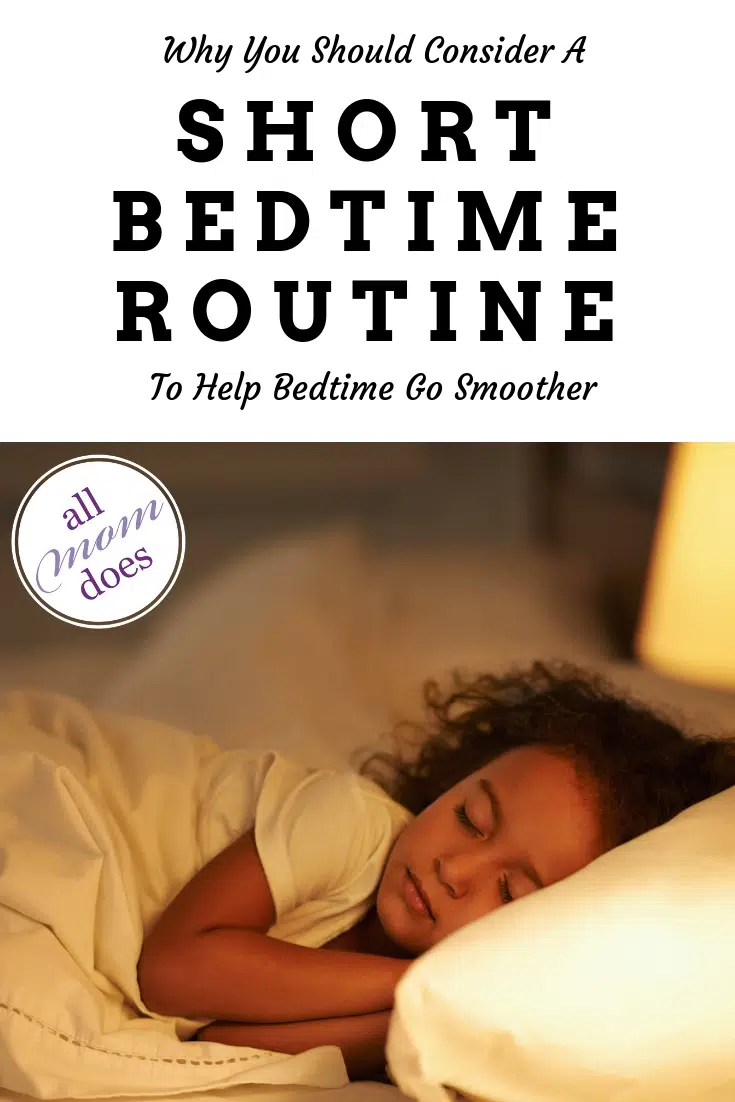There’s no doubt that a bedtime routine is important to kids. Moms everywhere know this; it’s asserted in every parenting book and article ever written. But sometimes I think in an effort to do the very best thing for our kids, we go a little too far.
We start to think that if a 20-minute bedtime routine is good, a 30-minute one is probably better. And then we hear about all the sweet components that other moms incorporate into their kids’ bedtime routines and we try to do the same and before we know it we’ve locked ourselves into a 60-to-90-minute bedtime routine that we have to do. Every night. Sometimes with multiple children.
Mom, enough is enough. It’s time to take back bedtime. In my home the bedtime routine lasts 5 minutes. 10, tops. It consists of brushing teeth, putting on pajamas, saying a prayer, and turning out the lights. That’s it – and that’s pretty much always been it. And while we’ve certainly had our share of frustrating moments, the “back-in-your-bed” battle once they learned they could get out of bed after switching to a toddler bed, and the occasional litany of ridiculous excuses for extending bedtime, overall bedtime throughout the years has been pretty easy.
This strategy might not work for every child and every family, but a short bedtime routine has worked for ours. Here are some reasons that have helped me come to believe that a brief bedtime routine is actually more helpful in getting a child ready for sleep than a lengthy one.
Why A Short Bedtime Routine Works Better
Kids can’t separate “bedtime” and “bonding time” so of course they want it to last forever. Bedtime has become synonymous with bonding time. Songs, stories, snuggles. Those things are all sweet, but if you do all these things while putting your child into bed it’s no wonder that they beg to extend it. They love doing all those things with you, so they’re gonna try to make it last as long as humanly possible. I’m not saying you shouldn’t do all those wonderful things with your child (you absolutely should), but I think it’s helpful to separate them from bedtime. At bedtime a child should expect to sleep, not snuggle and read books.
A routine doesn’t always condition your child to sleep when they’re in bed. Best practices in adult sleep science say that your bed should be used only for sleeping. You shouldn’t watch TV or read, and if you’re suffering from a bout of insomnia you should get up and move to another room until you feel tired. This is because if you do other things besides sleep in bed, you condition your body to be awake in that environment. If you snuggle and read and spend a half an hour with your child in their bed engaging with them and then expect them to sleep, you may be conditioning them to be awake in bed rather than asleep. Your child should expect to sleep when they’re in bed – and some routines can accidentally condition them to be awake.
Daily baths aren’t good for a baby’s skin – and aren’t even necessary until your kids are about 12. Bathtime is a common component of a “good” bedtime routine, but the AAP warns that too-frequent bathing can actually dry out your baby’s skin. Kids can start bathing daily at age 6 according to the American Academy of Dermatology, but often they only need a bath once or twice a week (depending on activity level). So don’t feel guilty if your bedtime routine doesn’t include a bath. It’s not necessary.
If you start with a long bedtime early on, you’re committed. You know how well kids (especially young kids) adjust to changes in routine. If you have a 90-minute routine with your baby, they’re not gonna tolerate you cutting out parts of it when they’re a toddler. If you haven’t implemented a routine yet, make it easy on yourself and don’t lock yourself into a lengthy routine from the get-go that you’re going to have to keep up for years.
Tips to Implement a Short Bedtime Routine
If you’re ready to implement a brief bedtime routine, there are still some things you’ll need to do as the clock ticks closer to bedtime:
- Wind down prior to bedtime. Though you might not be doing a “routine,” bedtime prep still starts well before bedtime. Screens and wild activity amp up kids and make it difficult to fall asleep. Turn off the television and have the kids play with quieter activities. You can absolutely include snuggling and reading stories in this part of your evening – but read to your child on the couch in the living room, not in bed.
- Give lots of warnings. Even though your bedtime routine is brief, it shouldn’t be a surprise. Tell your children frequently that bedtime is imminent – I tend to give 30-minute, 15-minute, 10-minute, and 5-minute warnings. If your kids tend to beg for food at bedtime, consider giving them a snack during this time before you round them up.
- Be firm about stalling tactics. If you give in once, they’re gonna try again the next night – and it will be even worse because they got their way last time. Have your kids keep a water bottle by their bed for when they cry “I’m thirsty!” and if you have a preschooler or older, be firm when they complain that they want a snack. Remind them that they had plenty of opportunities and that tomorrow they will have another chance to make a different decision. This may be the toughest part but – trust me – they’re not starving and will learn quickly.
Bedtime can be one of the most difficult parts of the day because by that point you’re completely worn out, so it’s in your best interest to keep it as short and easy as possible. Turns out, it might actually work better for your child, too.
How long does bedtime last in your house?
RELATED:
Dear Bedtime Routine, You Exhause Me
Our Favorite Excuses for Extending Bedtime
How Our Bedtime Routine Rescues Our Day
I’m a Stickler for Early Bedtimes

 Read more of Kristina’s contributions to allmomdoes here.
Read more of Kristina’s contributions to allmomdoes here.

















